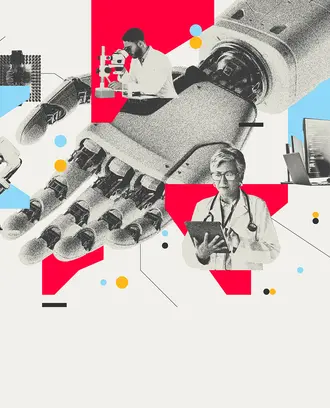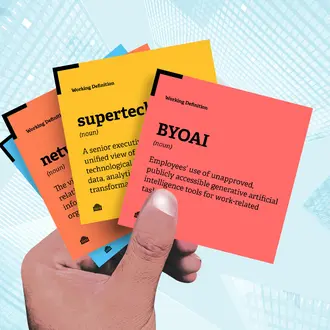Credit: Israel Vargas
Successfully leading a company into the future is no longer about 30-year strategic plans, or even 5- or 10-year roadmaps. It’s about people across an organization adopting a strategic mindset and working in flexible teams that allow companies to respond to evolving technology and external risks like geopolitical conflict, pandemics, and the climate crisis.
Increasingly that agility requires a shift from reliance on command-and-control leadership to distributed leadership, which emphasizes giving people autonomy to innovate and using noncoercive means to align them around a common goal. MIT Sloan professor defines distributed leadership as collaborative, autonomous practices managed by a network of formal and informal leaders across an organization.
“Top leaders are flipping the hierarchy upside down,” said MIT lecturer who collaborates with Ancona on research about teams and nimble leadership.
“Their job isn't to be the smartest people in the room who have all the answers,” Isaacs said, “but rather to architect the gameboard where as many people as possible have permission to contribute the best of their expertise, their knowledge, their skills, and their ideas.”
A 2015 paper by Ancona, Isaacs, and Elaine Backman, “Two Roads to Green: A Tale of Bureaucratic versus Distributed Leadership Models of Change,” examined the different leadership approaches of two firms rolling out sustainability initiatives companywide.
The researchers judged the successes and challenges of the two firms based on four key capabilities:
- Relating: Seeing the environment through others’ perspectives, developing supportive relationships, and bringing people together.
- Sensemaking: Creating and updating maps of a complex environment in order to act more effectively in it.
- Visioning: Linking a leader’s picture of the future with the organization’s overall mission.
- Inventing: Creating new structures or processes to bring a vision to fruition.
The company that engaged these capabilities and enacted distributed leadership fared better than the one with a more command-and-control leadership model. Employees in the distributed organization were able to tap into new ways of working with one another, spreading ideas throughout the company and innovating more quickly under a shared mission.
“It’s creating an organization whose culture is about learning, innovation, and entrepreneurial behavior,” Ancona said. “It’s not ‘Who’s to blame for this failure?’ but ‘What did we learn, and how can we improve?’”
To help leaders avoid pitfalls while moving to a distributed leadership model, Ancona and Isaacs offer a checklist:
- When people at lower levels of the firm have ideas on new strategic objectives that have been vetted and tested, let those people participate in leading the change process.
- Give people a say in matching themselves with roles. Engage in two-way dialogue with potential candidates to consider who has the passion, knowledge, networks, and time availability to succeed — regardless of a person’s role or level in the organizational hierarchy.
- Have an honest conversation with potential team members about their capacity to implement and what they can commit to the team.
- Provide coaching and learning opportunities so that people can practice the decision- making, entrepreneurial activity, and influencing skills needed to work in this mode of operating. Provide opportunities for employees to meet one another and network across the firm.
- Remember that moving away from a command-and-control mode of operating does not mean that senior leaders cease to play a role in the change process. They are the architects who facilitate and enable entrepreneurial activity.
- Achieving change will require some combination of command-and-control and cultivate-and-coordinate styles.
If the shift to distributed leadership feels overwhelming, start with incremental steps.
“You can do a lot just by having everybody on your team go interview a customer, take a look at where AI is making the most impact, explore new directions that your competition is going in, or examine whatever is most important to learn,” Ancona said. “Then everyone can report out and the whole team can learn. We don't want to set up this huge model that people think of as a step too far. You can start small.”
Senior leaders must set strategic priorities and model the tone from the top, Isaacs said. This demonstrates to workers that leadership is on board with a new way of working. It’s also critical for them to hold the organization accountable to its cultural values in order to foster the collective trust that fuels a distributed leadership model.
“More and more employees are used to being autonomous and empowered,” Isaacs said. “The younger generations are growing up in a networked world in which they are used to expressing their creativity and autonomy. Nimble organizations offer them that opportunity.”
Read: The 3 leadership types in a nimble organization



